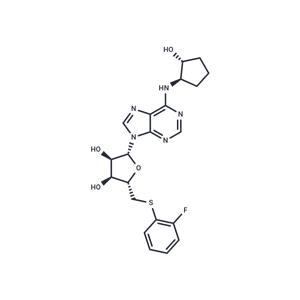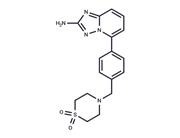| Name | GS-9667 |
| Description | GS-9667, a selective and partial agonist of the A(1) adenosine receptor (AR), represents an effective therapy for Type 2 diabetes (T2DM) and dyslipidemia via lowering of free fatty acids (FFA). |
| In vivo | In the single ascending dose study, healthy, non-obese, and obese subjects received GS-9667 (30-1,800 mg; oral; single dose). In the multiple, ascending dose study, healthy, obese subjects received GS-9667 (600-2,400 mg QD, 1,200 mg BID, or 600 mg QID) for 14 days. Doses of GS-9667 ≥300 mg caused dose-dependent reductions in FFA levels that were reproducible over 14 days without evidence of desensitization or rebound. All doses were well tolerated. GS-9667 was rapidly absorbed and distributed; Steady-state concentrations were achieved within 3-5 days. The A(1) AR partial agonist GS-9667 reduced plasma FFA, exhibited linear kinetics, and was well-tolerated in healthy non-obese and obese subjects.[1] |
| Storage | Powder: -20°C for 3 years | In solvent: -80°C for 1 year | Shipping with blue ice. |
| Solubility Information | DMSO : 55 mg/mL (119.17 mM)
|
| Keywords | CVT3619 | GS-9667 | GS9667 | GS 9667 |
| Inhibitors Related | Theophylline monohydrate | Diphylline | Acefylline | Nitrobenzylthioinosine | Aminophylline | Inosine | Theobromine | Istradefylline | Theophylline | Adenosine antagonist-1 | Doxofylline | FK-453 |
| Related Compound Libraries | Bioactive Compound Library | Membrane Protein-targeted Compound Library | Bioactive Compounds Library Max | GPCR Compound Library |

 United States
United States



